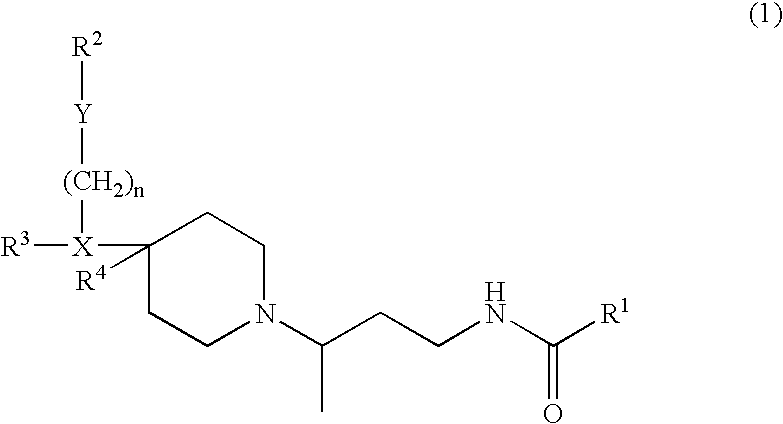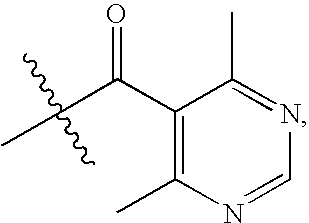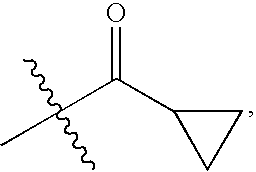Chemokine receptor binding compounds
a technology of chemokine receptors and binding compounds, which is applied in the field of new compounds and pharmaceutical compositions, can solve the problems of hematopoiesis and cardiogenesis, lethal deficiencies in vascular development, and drug compositions
- Summary
- Abstract
- Description
- Claims
- Application Information
AI Technical Summary
Benefits of technology
Problems solved by technology
Method used
Image
Examples
example 1
[0348]
[0349] Preparation of 6-Chloro-N—((R)-3-{4-[(4-methoxy-phenyl)-(4-methyl-pyridin-3-ylmethyl)-amino]-piperidin-1-yl}-butyl)-2,4-dimethyl-nicotinamide
[0350] To a solution of [1-((R)-3-amino-1-methyl-propyl)-piperidin-4-yl]-(4-methoxy-phenyl)-(4-methyl-pyridin-3-ylmethyl)-amine (63 mg, 0.17 mmol) in DMF (1.5 mL) was added 6-chloro-2,4-dimethyl-nicotinic acid (40 mg, 0.22 mmol), HOBT (31 mg, 0.23 mmol), EDCI (44 mg, 0.23 mmol) and DIPEA (85 μL, 0.50 mmol). After the mixture was stirred at room temperature overnight brine (5 mL) was added, and the mixture was extracted with CH2Cl2 (2×5 mL). The organic extracts were combined and dried (Na2SO4). After filtration the solvent was removed under vacuum, and the residue was purified by flash chromatography on a silica gel column (20:1:0.1, CH2Cl2 / MeOH / NH4OH) to afford the title compound as a white solid (72 mg, 80%). 1H NMR (CDCl3) δ 0.98 (d, 3H, J=6.6 Hz), 1.00 (m, 1H), 1.19 (m, 1H), 1.54 (m, 1H), 1.71 (m, 1H), 1.80 (br d, 2H, J=12.6 H...
example 2
[0351]
[0352] Preparation of 4-Cyano-N—((R)-3-{4-[[4-(2-methoxy-ethoxy)-phenyl-(4-methyl-pyridin-3-ylmethyl)-amino]-piperidin-1-yl}-butyl)-2,6-dimethyl-benzamide
[0353] To a solution of 4-nitrophenol (2.16 g, 15.5 mmol) in DMF (8 mL) was added 2-bromoethyl methyl ether (1.9 mL, 20.2 mmol) and K2CO3 (4.08 g, 29.6 mmol) and the reaction stirred at 60° C. for 3 h then at 80° C. for 2 h. The mixture was cooled and diluted with H2O (30 mL) and EtOAc (40 mL) and the aqueous layer extracted again with EtOAc (1×25 mL). The combined organic extracts were washed with brine (2×20 mL), dried (Na2SO4) and concentrated to afford the desired ether (3.05 g) as a white solid.
[0354] The 4-nitrophenol (3.05 g), MeOH (30 mL), 10% Pd on activated carbon, (304 mg) were combined in a hydrogenation vessel and the reaction mixture was shaken on a Parr hydrogenator for 1 h at 40 psi of hydrogen. The mixture was filtered through celite, the cake washed with MeOH and the solvent from the eluent removed in vacu...
example 3
[0359]
[0360] Preparation of N—((R)-3-{4-[(4-Methoxy-phenyl)-(4-methyl-pyridin-3-ylmethyl)-amino]-piperidin-1-yl}-butyl)-2,6,N′,N′-tetramethyl-terephthalamide
[0361] (R)-[1-(3-Amino-1-methyl-propyl)-piperidin-4-yl]-(4-methoxy-phenyl)-(4-methyl-pyridin-3-ylmethyl)-amine (1.00 g, 2.62 mmol), EDCI (0.55 g, 2.88 mmol) and HOBT (0.39 g, 2.88 mmol) were combined in DMF (5 mL) to give a pale yellow solution. To this solution was added 4-cyano-2,6-dimethyl-benzoic acid (0.50 g, 2.88 mmol) followed by DIPEA (1.14 mL, 6.55 mmol) and the resulting mixture was stirred at 25° C. for 16 h. Standard workup according to General Procedure C gave the crude product as a tan oil. Purification by column chromatography on silica gel (CH2Cl2:MeOH:NH4OH, 96:3:1, v / v / v) afforded 4-cyano-N—((R)-3-{4-[(4-methoxy-phenyl)-(4-methyl-pyridin-3-ylmethyl)-amino]-piperidin-1-yl}-butyl)-2,6-dimethyl-benzamide (0.77 g, 54%) as a white foam. 1H NMR (CDCl3) δ 0.98-1.04 (d+m, 4H), 1.22 (m, 1H), 1.54 (m, 1H), 1.73-1.82 (m,...
PUM
| Property | Measurement | Unit |
|---|---|---|
| Composition | aaaaa | aaaaa |
Abstract
Description
Claims
Application Information
 Login to View More
Login to View More - R&D
- Intellectual Property
- Life Sciences
- Materials
- Tech Scout
- Unparalleled Data Quality
- Higher Quality Content
- 60% Fewer Hallucinations
Browse by: Latest US Patents, China's latest patents, Technical Efficacy Thesaurus, Application Domain, Technology Topic, Popular Technical Reports.
© 2025 PatSnap. All rights reserved.Legal|Privacy policy|Modern Slavery Act Transparency Statement|Sitemap|About US| Contact US: help@patsnap.com



